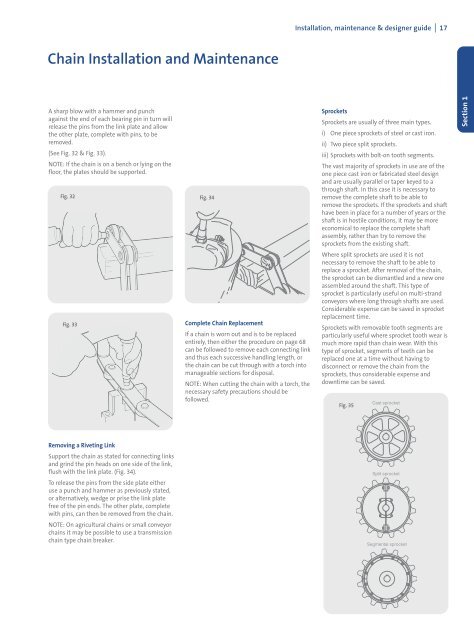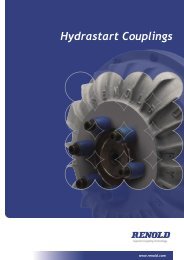Conveyor chain
Conveyor chain
Conveyor chain
You also want an ePaper? Increase the reach of your titles
YUMPU automatically turns print PDFs into web optimized ePapers that Google loves.
Chain Installation and Maintenance<br />
A sharp blow with a hammer and punch<br />
against the end of each bearing pin in turn will<br />
release the pins from the link plate and allow<br />
the other plate, complete with pins, to be<br />
removed.<br />
(See Fig. 32 & Fig. 33).<br />
NOTE: If the <strong>chain</strong> is on a bench or lying on the<br />
floor, the plates should be supported.<br />
Fig. 32 Fig. 34<br />
Fig. 33<br />
Removing a Riveting Link<br />
Support the <strong>chain</strong> as stated for connecting links<br />
and grind the pin heads on one side of the link,<br />
flush with the link plate. (Fig. 34).<br />
To release the pins from the side plate either<br />
use a punch and hammer as previously stated,<br />
or alternatively, wedge or prise the link plate<br />
free of the pin ends. The other plate, complete<br />
with pins, can then be removed from the <strong>chain</strong>.<br />
NOTE: On agricultural <strong>chain</strong>s or small conveyor<br />
<strong>chain</strong>s it may be possible to use a transmission<br />
<strong>chain</strong> type <strong>chain</strong> breaker.<br />
Complete Chain Replacement<br />
If a <strong>chain</strong> is worn out and is to be replaced<br />
entirely, then either the procedure on page 68<br />
can be followed to remove each connecting link<br />
and thus each successive handling length, or<br />
the <strong>chain</strong> can be cut through with a torch into<br />
manageable sections for disposal.<br />
NOTE: When cutting the <strong>chain</strong> with a torch, the<br />
necessary safety precautions should be<br />
followed.<br />
Installation, maintenance & designer guide I 17<br />
Sprockets<br />
Sprockets are usually of three main types.<br />
i) One piece sprockets of steel or cast iron.<br />
ii) Two piece split sprockets.<br />
iii) Sprockets with bolt-on tooth segments.<br />
The vast majority of sprockets in use are of the<br />
one piece cast iron or fabricated steel design<br />
and are usually parallel or taper keyed to a<br />
through shaft. In this case it is necessary to<br />
remove the complete shaft to be able to<br />
remove the sprockets. If the sprockets and shaft<br />
have been in place for a number of years or the<br />
shaft is in hostile conditions, it may be more<br />
economical to replace the complete shaft<br />
assembly, rather than try to remove the<br />
sprockets from the existing shaft.<br />
Where split sprockets are used it is not<br />
necessary to remove the shaft to be able to<br />
replace a sprocket. After removal of the <strong>chain</strong>,<br />
the sprocket can be dismantled and a new one<br />
assembled around the shaft. This type of<br />
sprocket is particularly useful on multi-strand<br />
conveyors where long through shafts are used.<br />
Considerable expense can be saved in sprocket<br />
replacement time.<br />
Sprockets with removable tooth segments are<br />
particularly useful where sprocket tooth wear is<br />
much more rapid than <strong>chain</strong> wear. With this<br />
type of sprocket, segments of teeth can be<br />
replaced one at a time without having to<br />
disconnect or remove the <strong>chain</strong> from the<br />
sprockets, thus considerable expense and<br />
downtime can be saved.<br />
Fig. 35<br />
Section 1




